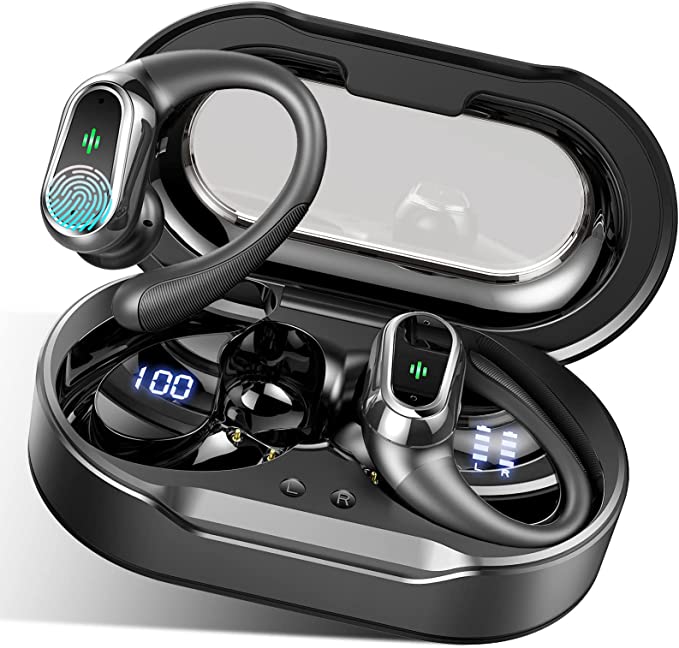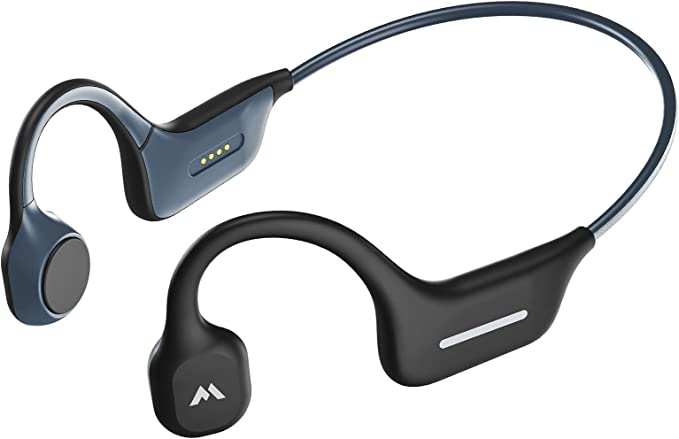They perch weightlessly in our ears, tiny conduits piping music, podcasts, and voices directly into our lives. Wireless earbuds have become nearly ubiquitous, yet it’s easy to take their complex inner workings for granted. How does that seamless stream of audio reach you? Why do some calls sound crystal clear while others are a garbled mess? What keeps them stubbornly in place during a workout, defying gravity and sweat?
These aren’t magic tricks; they’re feats of engineering, a delicate symphony of physics, materials science, and sophisticated electronics packed into an incredibly small space. To truly appreciate these everyday marvels, let’s peel back the layers. We’ll use the Kuizil Q76-BY wireless earbuds – described in their product information as sports-focused earbuds with features typical of many modern offerings – as our guide. This isn’t a product review, but rather an exploration, a journey into the science and ingenuity that powers the soundtrack of our modern lives.

The Invisible Thread: Decoding Bluetooth 5.3’s Promise of Stability
Remember the early days of Bluetooth audio? The frustrating skips, the sudden dropouts, the lag that made videos unwatchable? That experience highlights a fundamental challenge: sending a consistent stream of data wirelessly through an increasingly crowded radio environment. The Kuizil Q76-BY description mentions employing Bluetooth 5.3, touting a “much stronger and more stable signal” compared to previous versions. What does that really mean?
Think of the radio frequency spectrum like a multi-lane highway. Early Bluetooth versions were like cars navigating this highway with basic maps, easily getting stuck in traffic (interference from Wi-Fi, microwaves, other Bluetooth devices). Bluetooth technology has evolved significantly. While Bluetooth 5.0 brought major leaps in range and data capacity, subsequent versions like 5.1, 5.2, and 5.3 (based on general information from the Bluetooth Special Interest Group, the governing body) have focused heavily on refinement – improving efficiency, connection reliability, and coexistence in those “traffic jams.” Bluetooth 5.3, for instance, incorporates enhancements allowing devices to be smarter about choosing cleaner transmission channels and managing connections more efficiently, especially important for battery life and maintaining a steady link.
So, when the Q76-BY information claims a more stable signal and less worry about “interruptions on calling,” it’s likely leveraging these underlying improvements inherent in the Bluetooth 5.3 standard. For the user, this translates directly into a smoother experience: fewer annoying audio stutters during a jog through a busy park, calls that don’t unexpectedly drop, and videos where the audio syncs seamlessly with the picture (“almost no delay for watching videos,” as the description notes). The claim of “instantaneous” connection upon opening the case also points to optimizations in the pairing and reconnection protocols, reducing that initial waiting game. It’s about making the wireless connection feel less like a fragile thread and more like a reliable lifeline.

Crafting Your Personal Sound Bubble: The Dance of Drivers and Call Clarity (ENC)
Wireless earbuds face a dual audio challenge: faithfully reproducing the nuances of your favorite music and ensuring your voice is heard clearly during phone calls, even amidst chaos. The Q76-BY description highlights two key elements here: “13mm large size speaker drivers” for “high-fidelity audio” and “ENC noise cancelling” for clear calls. Let’s unpack these.
Inside each earbud lies a driver – think of it as the heart of the sound system, a miniature version of a traditional loudspeaker. It typically consists of a diaphragm (a thin membrane), a voice coil, and a magnet. Electrical signals make the coil move within the magnetic field, causing the diaphragm to vibrate rapidly, pushing air and creating the sound waves we perceive. The size of the driver, like the 13mm specified for the Q76-BY, can influence its acoustic properties. Generally speaking, a larger diaphragm has the physical potential to move more air, which can be advantageous for reproducing low-frequency sounds – the “deep, rich bass” mentioned in the description. However, achieving true “high-fidelity” (accurate sound reproduction across the frequency spectrum) is far more complex than just size. It involves the diaphragm’s material, the motor system’s precision, the acoustic chamber design, and, crucially, electronic tuning to balance the “crisp, clear high notes” with that bass foundation for an overall “immersive sound.”
Now, let’s talk about calls and “ENC noise cancelling.” This term often causes confusion, so let’s be precise. This is not the same as Active Noise Cancellation (ANC), which uses microphones to listen to your surroundings and create anti-noise waves to cancel out ambient sound for your listening pleasure. ENC, or Environmental Noise Cancellation, as described for the Q76-BY (“Two microphones… work efficiently to ensure your voice is heard clearly”), focuses on the outbound signal – your voice. Imagine you’re on a call from a noisy street. The earbuds use their microphones (likely one primarily aimed at your mouth, perhaps another capturing ambient sound) and clever signal processing algorithms. These algorithms identify the background noise – the traffic, the chatter – and digitally subtract it from the signal carrying your voice before transmitting it to the person you’re talking to. The goal isn’t to make the world quieter for you, but to make you sound clearer and more isolated from the surrounding din for them. This is crucial for making calls from less-than-ideal environments without having to shout or repeat yourself.

Locked In and Ready for Anything: The Physics of Fit and the Shield of IP7
For anyone who’s tried exercising with earbuds, two adversaries quickly emerge: gravity, threatening to pull them out with every jump, and moisture (sweat or rain), posing a threat to the delicate electronics. The Kuizil Q76-BY description addresses these with two key design features: “adjustable, secure-fit earhooks” and an “IP7 Waterproof” rating.
The earhooks tackle the mechanical challenge of stability. Think of them as ergonomic anchors. Instead of relying solely on the fit within the ear canal, the hook loops over the top of the outer ear (the pinna), using its structure as a leverage point. This provides a much more secure fit, especially during dynamic movements like running or jumping, counteracting the forces trying to dislodge the earbud. The description emphasizes “soft, flexible” materials, likely a thermoplastic polyurethane (TPU) or similar polymer, chosen for comfort during extended wear and resilience. Combined with the three sizes of silicone eartips (S, M, L) mentioned, the goal is a personalized, secure, yet comfortable seal – vital not only for stability but also for optimal sound delivery (a poor seal leaks bass).
Then there’s the shield against moisture: the IP7 rating. “IP” stands for Ingress Protection, and it’s part of an international standard (IEC 60529) that classifies how well a device is protected against intrusion from solids (first digit, often ‘X’ if untested) and liquids (second digit). The ‘7’ in IP7 specifically relates to water. According to the standard, a device rated IPx7 can withstand temporary immersion in water up to 1 meter deep for up to 30 minutes. This doesn’t mean they’re designed for swimming (consistent pressure at depth is different), but it provides significant peace of mind against heavy sweat during intense workouts, running in the rain, or even an accidental quick drop into a puddle. It signifies a level of robustness crucial for earbuds intended for sports and active use.
The Unseen Endurance: Untangling Battery Life and Smart Charging
The ultimate freedom of wireless technology is often tethered by battery life. Constantly worrying about whether your earbuds will last through your commute or workout can be a drag. The Q76-BY details claim a respectable “10H of working on a single full charge,” significantly extended by the charging case to a total of “up to 50H.” How is this achieved?
Inside the earbuds and the case are likely Lithium Polymer (Li-Po) batteries. This battery chemistry is favored in small electronics because it offers a good balance of energy density (storing a lot of power in a small, light package) and can be molded into various shapes. Achieving 10 hours from the earbuds themselves suggests efficient power management by the Bluetooth chip and audio circuitry. The charging case acts as a portable power bank, holding multiple full charges for the earbuds (in this case, enough for an additional 40 hours). A 50-hour total playtime translates to potentially several days, or even a week, of typical use between needing to plug the case itself in.
Recharging convenience is also considered. The mention of a USB-C port aligns with the modern standard, offering a reversible connector that’s becoming ubiquitous. The specified charge times (1.5 hours for earbuds, 2 hours for the case) give an idea of turnaround speed. But perhaps the most user-friendly touch described is the “dual digital LED display.” Knowing the exact power status avoids guesswork. The case showing its own remaining power as a percentage, and the earbuds’ status via a separate grid, provides clear, at-a-glance information. The addition of a “transparent window” to check this without even opening the lid is a thoughtful detail, removing a small but frequent point of friction in the daily user experience. It transforms the case from just a charger into an informative power hub.

Command at Your Fingertips: The Simplicity of Touch
In the quest for seamless interaction, fumbling for your phone to skip a track or answer a call feels increasingly clunky, especially when you’re active. The Q76-BY earbuds, according to the description, feature a “multi-function touch panel on each in-ear headphone.” This is a common feature in modern earbuds, typically relying on capacitive sensing.
Your body has natural electrical capacitance. The touch panel contains electrodes that maintain a stable electrostatic field. When your finger (which is conductive) approaches or touches the panel, it disrupts this field. Sensors detect this change in capacitance and translate it into a command – a tap for play/pause, a double-tap to skip, a hold to adjust volume or summon a voice assistant (like Siri or Google Assistant), or a tap to answer/end calls, as listed in the Q76-BY’s capabilities. The beauty lies in its invisibility and immediacy. It allows for quick, intuitive control directly on the earbuds, keeping your phone tucked away and your focus on your activity, whether it’s navigating a busy street, concentrating on your workout, or simply relaxing without wanting to reach for another device.
The Symphony of Science in Your Ears
So, the next time you pop in your wireless earbuds, take a moment to appreciate the intricate symphony playing out behind the scenes. It’s not just one breakthrough technology, but a careful orchestration of advancements: the radio frequency finesse of Bluetooth ensuring a stable connection, the acoustic precision of drivers translating electrical signals into rich sound, the clever algorithms of ENC isolating your voice, the material science and ergonomic design locking them comfortably in place while resisting the elements, the energy density of batteries providing hours of power, and the intuitive simplicity of touch controls putting command at your fingertips.
Understanding this interplay of science and engineering doesn’t just demystify the technology; it empowers us. It allows us to appreciate the ingenuity packed into these tiny devices and perhaps make more informed choices based on the features that truly matter to our individual needs. The journey of wireless audio is constantly evolving, pushing towards even smaller, smarter, and more capable devices. But even today, the earbuds we often take for granted stand as remarkable testaments to how complex science seamlessly integrates into the fabric of our daily lives, delivering our personal soundtracks on demand.




